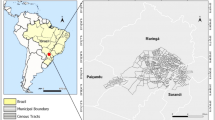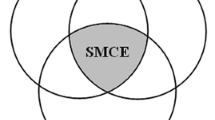Abstract
In spite of progress achieved in the research of environmental impact assessment (EIA), the problem of weight distribution for a set of parameters has not as yet, been properly solved. This paper presents an approach of objective weighting by using a procedure of P ij principal component-factor analysis (P ij PCFA), which suits specifically those parameters measured directly by physical scales. The P ij PCFA weighting procedure reforms the conventional weighting practice in two aspects: first, the expert subjective judgment is replaced by the standardized measure P ij as the original input of weight processing and, secondly, the principal component-factor analysis is introduced to approach the environmental parameters for their respective contributions to the totality of the regional ecosystem. Not only is the P ij PCFA weighting logical in theoretical reasoning, it also suits practically all levels of professional routines in natural environmental assessment and impact analysis. Having been assured of objectivity and accuracy in the EIA case study of the Chuansha County in Shanghai, China, the P ij PCFA weighting procedure has the potential to be applied in other geographical fields that need assigning weights to parameters that are measured by physical scales.
Similar content being viewed by others
References
Aiking, H., Govers, H. A. J., Kenlen, R. W., Hermens, P. A. H., and Jeltes, R.: 1989, ‘A General Approach to Environmental health Impact Assessment in The Netherlands’, in D. D. Heoophill (ed.), Trace Substance in Environmental Health — XXII, University of Missouri, pp. 98–108.
Alberti, M. and Parker, J. D.: 1991, ‘Indices of Environmental Quality: The Search for Credible measures’, Environ. Impact Assess. Rev. 11, 95–101.
Barton, D. R. and Metcalfe-Smith, J. L.: 1992, ‘A Comparison of Sampling Techniques and Summary Indices for Assessment of Water Quality in the Yamaska River, Quebec, based on Benthic Macroinvertebrates’, Environ. Monit. Assess. 21, 225–44.
Beinat, E., Nijkamp, P. and Rietveld, P.: 1994, ‘Value Functions for Environmental Pollutants: A Technique for Enhancing the Assessment of Expert Judgments’, Environ. Monit. Assess. 30, 9–23.
Brown, R. M., McClelland, N. I., Deininger, R. A., and Tozer, R. G.: 1970, ‘A Water Quality Index — Do We Dare?’ Water Sewage Works (October), 339–343.
Canter, L. W.: 1983, ‘Methods for Environmental Impact Assessment: Theory and Application (Emphasis on Weighting-scaling Checklists and Networks)’, PADC EIA and Planning Units (eds.), Environmental Impact Assessment, Martinus Nijhoff Publishers, The Hague, The Netherlands.
Clark, B. D., Bisset, R., and Wathern, P.: 1980, Environ. Impact Assess. Mansell Publishing, London.
Cullen, P.: 1975, ‘Techniques for Evaluating Environmental Impacts’ in: Australian Conservation Foundation (eds.), The EIS Technique, Australian Conservation Foundation Melbourne, pp. 30–35.
Dee, N. B., Baker, J., Drobny, N., and Duke, K.: 1973, ‘An Environmental Evaluation System for Water Resources Planning’, Water Resources Research 9, 523–535.
Department of the Army Pamphlet: 1975, Handbook for Environmental Impact Analysis, Headquarters, Department of the Army.
Duke, K. M. et al.: 1977, Environmental Quality Assessment in Multiobjective Planning, Battelle Columbus Laboratories Columbus, Ohii, (PB - 279 219).
Enk, G. A., and Hornick, W. F.: 1983, ‘Human Values and Impact Assessment’ in: A. Rossini and A. L. Porter (eds.), Integrated Impact Assessment Westview Press, Boulder, CO, pp. 56–71.
Erikson, P. A.: 1979, Environmental Impact Assessment — Principles and Application, Academic Press, New York.
Goddard, J., and Kirby, A.: 1976, An Introduction to Factor Analysis (CATMOG 7), Geo Abstracts Ltd., University of East Anglia, Norwich, UK.
Hobbs, B. F. and Voelker, A. H.: 1978, Analytical Multiobjective Decision-Making Techniques and Power Plant Siting: A Survey and Critique, prepared for the Department of Energy, Oak Ridges, TN, Oak Ridges National Laboratory.
Hobbs, B. F., Rowe, M. D., Pierce, B. L., and Meier, P. M.: 1984, ‘Comparisons of Methods for Evaluating Multi-alternatives in Environmental Assessments’, in: S. L. Hart et al. (eds.), Improving Impact Assessment, Westview Press, Boulder, CO, pp. 227–251.
Hobbs, B. F.: 1985, ‘Choosing How to Choose: Comparing Amalgamation Methods for Environmental Impact Assessment’, Environ. Impact Assess. Rev. 5, 301–309.
Hollick, M.: 1981, ‘The Role of Quantitative Decision-making Methods in Environmental Impact Assessment’, J. Environ. Management 12, 65–78.
Horton, R. K.: 1865, ‘An Index — Number System for Rating Quality’, J. Water Poll. Control Fed. 37, 300–306.
Hyman, E. L., and Stiftel, B.: 1988m ‘A Review and Analysis of Fourteen Environmental Assessment Methods’, Combining Facts and Values in Environmental Impact Assessment, Westview Press, Boulder, CO, pp. 155–223.
Inhaber, H.: 1974, ‘Environmental Quality: Outline for A National Index for Canada’, Science 186, 376–378.
Inhaber, H.: 1976, Environmental Indices. New York, John Wiley & Sons.
Inhaber, H.: 1977, ‘Indices of Environmental Quality and Their Use in Environmental Assessment’, in: M. Plewes and J. B. R. Whitney (eds.), Environmental Impact Assessment in Canada: Processes and Approaches, Toronto, University of Toronto, Institute for Environmental Studies, pp. 99–107.
Interorganizational Committee on Guidelines and Principles for Social Impact Assessment: 1995, ‘Guidelines and principles for Social Impact Assessment’, Environ. Impact Assess. Rev. 15, 11–43.
Johnston, R. J.: 1978, Multivariate Statistical Analysis in geography, Longman Inc. New York.
Kachigan, S. K.: 1986, Statistical Analysis: An Interdisciplinary Introduction to Univariate and Multivariate Methods, Radius Press. New York.
Keeney, R. L. and Nair, K.: 1977, ‘Nuclear Siting using Decision Analysis’, Energy Policy 5, 223–231.
Kim, J., and Mueller, C. W.: 1978, Factor Analysis: Statistical Methods and Practical Issues. SAGE Publications, Inc. Newbury Park, California.
Krauskopf, T. M., and Bunde, D. C.: 1972, ‘Evaluation of Environmental Impact through A Computer Modeling Process’, in: R. Ditton and T. Goodale (eds.), Environmental Impact Analysis: Philosophy and Methods University of Wisconsin Dea Grant program, Madison, Wisconsin, pp. 107–125.
Kung, Hsiang-te and Ying, Long Gen: 1990, ‘Heavy Metal Concentrations in Soils and Crops of Baoshan-Eusong Area, Shanghai, China’, CATENA 17, 417–430.
Kung, Hsiang-te and Ying, Long Gen: 1991, ‘A Study of Lake Eutrophication in Shanghai, China’, The Geographical Journal. The Royal Geographical Society 157, (1), 1–6.
Kung, Hsing-te, Ying, Long Gen, and Liu, You-ci: 1993, ‘Fuzzy Clustering Analysis in Environmental Impact Assessment — A Complement Tool to Environmental Quality Index’, Environ. Monit. Assess. 28 (1), 1–14.
Lawley, D. N., and Maxwell, A. E.: 1971, Factor Analysis as A Statistical Method (2nd), Butterworths, London.
Lawrence, D. P.: 1993, ‘Quantitative versus Qualitative Evaluation: A False Dichotomy’? Environ. Impact Assess. Rev. 13, 3–11.
MacLaren, V. W.: 1986, ‘Multicriteria Evaluation Methods’, in: V. W. MaxLaren and J. B. Whitney (eds.), New Directions in Environmental Inpact Assessment, Methuen, Toronto.
Massam, B. H.: 1988, Multi-Criteria Decision-Making (MCDM) Techniques in Planning, Pergamon Press, Oxford.
Munn, R. E. (eds.): 1975, Environmental Impact Assessment. Principles and Procedures, SCOPE Report 5, Toronto: International Council of Scientific Unions, Scientific Committee on Problems of the Environment.
Odum, E. P.: 1975, ‘Totality Indices for Evaluating Environmental Impact: A test Case-Relative Impact of Highway Alternatives’, in: M. Blissett (eds.), Environmental Impact Assessment, Lyndon B. Johnson School of Public Affairs, University of Texas at Austin, Austin, Texas, pp. 153–158.
Ott, W. R.: 1980, Environmental Indices — Theory and Practice, Ann Arbor Science Publishers, Inc. Ann Arbor.
Peterson, G. L., Gemmell, R. S., and Schofer, J. L.: 1974, ‘Assessment of Environmental Impacts: Multidisciplinary Judgments of Large-Scale Projects’, Ekistics 37, 23–30.
Prati, L., Pavanello, R., and Pesarin, F.: 1971, ‘Assessment of Surface Water Quality by A Single Index of Pollution’, Water resources 5, 741–751. Ramamoorthy, S. and Baddaloo, E.: 1991, Evaluation of Environmental Data for Regulatory and Impact Assessment, Elsevier Science Publishers B. V. The Netherlands, pp. 50–86.
Reiquam, H., Dee, N., and Choi, P.: 1974, Development of Cross — Media Evaluation Methodology, Vols. I and II, Battelle Columbus Laboratories, Columbus, Ohio, (PB - 232 414).
Richardson, S.E. et al.: 1978, Preliminary Field Test of the Water Resources Assessment Methodology (WRAM); Tensas River, Lousiana, Miscellanneous Paper No. Y-78-1, Vicksburg, Mississippi, United States Army Corps of Engineers.
Ross, J.M.: 1976, The Numeric Weighting of Environmental Interactions, Occasional Paper No. 10, Ottawa: Lands Directorate, Environment Canada.
Shoji, H., Yamsmoto, T., and Nakamura, T.: 1966, ‘Factor Analysis on Stream Pollution of the Yodo River System’, Air and Water Pollution International Journal 10, 291–299.
Solomon, R. C. eaet al.: 1977, Water Resources Assessment Methodology (WRAM) — Impact Assessment and Alternative Evaluation. Technical report No. Y-77-1. Vicksburg, Mississippi, United States Army Corps of Engineers.
Sondheim, M. W.: 1978, ‘A Comprehensive Methodology for Assessing Environmental Impact’, J. Environmental Management 6, 27–42.
Sphere Environmental Consultants Ltd.: 1974, Loch Carron Area: Comprehensive Analysis of Platform Construction Sites. Sphere Environmental Consultants Ltd. London.
SPSS Inc.: 1988, SPSS — x User's Guide, SPSS Inc., Chicago, pp. 1072.
Thomas, W.A., (eds.), 1972, Indicators of Environmental Quality Plenum press, New York.
VHB Research and Consulting Inc., Loc Plan and Lawrence MacDonald and Associates: 1990, Evaluation Methods in Environmental Assessment, Queen's Printer for Ontario, Toronto.
Warner, M. L., and Preston, E. H.: 1974, Review of Environmental Impact Assessment Methodologies, US Environmental Protection Agency, Washington, D.C.
Wathern, P. (eds.): 1988, Environmental Impact Assessment: Theory and Practice Unwin Hyman Ltd, London.
Ying, Long Gen: 1986, ‘A Review of Weighting in EIA’, Systems Engineering 4 (4), 62–67 (in Chinese).
Ying, Long Gen: 1987, ‘Review of the progress in the U.S. EIA methodology’, J. Environmental Science 7 (1987), 1–14 (in Chinese).
Yu, Jing-sheng: 1985, Geological Factor Analysis, Geology Press, Beijing, (in Chinese).
Zadeh, L. A.: 1965, ‘Fuzzy Sets’, Information and Control 8, 338–353.
Zadeh, L. A.: 1973, ‘Outline of A New Approach to the Analysis of Complex Systems and Decision Process’, IEEE Trans. SMC 3, 28–44.
Author information
Authors and Affiliations
Rights and permissions
About this article
Cite this article
Ying, L.G., Liu, Y.C. A model of objective weighting for EIA. Environ Monit Assess 36, 169–182 (1995). https://doi.org/10.1007/BF00546788
Received:
Revised:
Issue Date:
DOI: https://doi.org/10.1007/BF00546788




